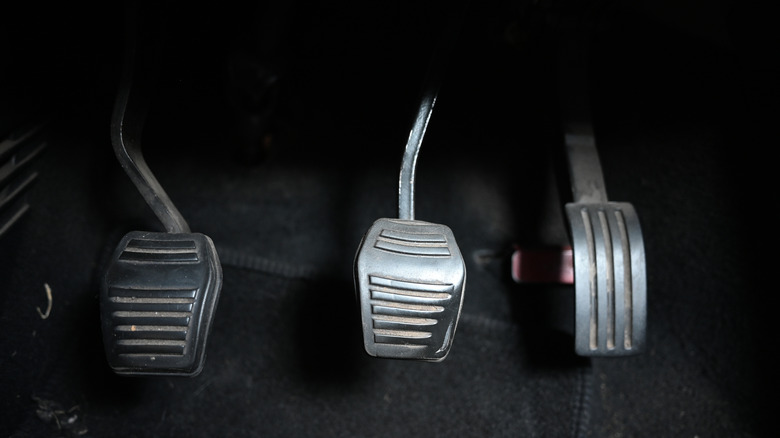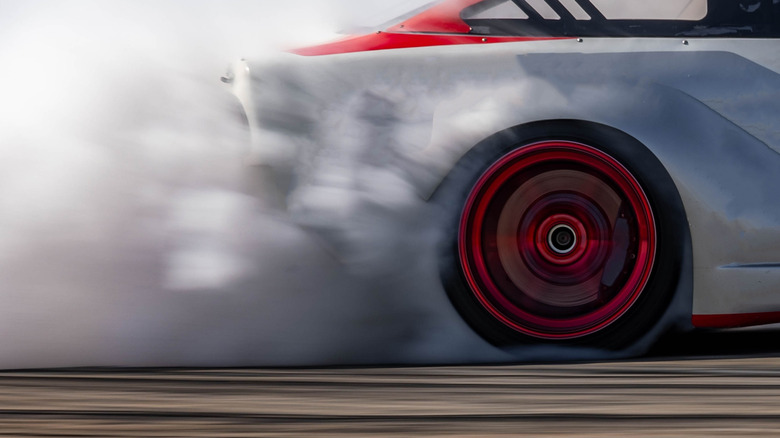What Would Happen If You Pressed The Gas And Brake Pedal At The Same Time
Cars frequently feature two, three, or sometimes four pedals, but we all know what the accelerator and brake do. That said, what happens if we were to press them both at the same time? Would the car just not go anywhere at all? What about at-speed; would it merely coast along?
The answer actually depends on the car and its on-board systems, for one. Let's say you have a vehicle equipped with a brake-throttle override (BTO) system; in that case, the on-board computer will cut the fuel and reduce the throttle. Basically, it effectively pretends you're not pressing the throttle pedal at all, only applying braking pressure as a result. This is particularly useful if, for instance, you panic-brake or try left-foot braking in a parking lot and nearly end up in an accident.
But what about cars where the throttle and brake are possible at the same time? Again, this depends on what the car is doing. There are specific situations where a driver might use both the brake and throttle simultaneously, either briefly or for an extended period. But for everyday driving, your brakes are generally going to be the more powerful system. After all, it generally takes far longer to accelerate to 60 than it does to decelerate from 60 to 0. That said, let's discuss precisely what occurs.
Applying the brake and throttle during normal driving
Let's say you rest your foot on the brake pedal just enough to engage the brake, but not enough to be noticeable. The way brakes work is by converting the forward momentum of the car into thermal energy and then dissipating that energy via the rotor or drum. Certain types of brakes, like drilled and/or slotted rotors, help dissipate this heat more quickly. However, typically brakes aren't meant to be left on all the time because they're not designed for that sort of application; this will lead to overheating and subsequent loss of braking performance, called brake fade.
Brake fade occurs because the friction material of the pad loses certain properties, but that's not the only end result of constant brake/throttle application. Another issue, especially in slotted rotors, is increased wear. If you're constantly pressing the pad up against the rotor at speed, this can damage one or both elements as well, meaning the possibility of a warped rotor, for instance.
Next, suppose you're idling in a parking lot, foot on the brake, and accidentally blip the throttle. The car may lurch, but unless you hit something by accident, it's nothing to worry about and won't directly harm your car, merely your pride. Still, left-foot braking isn't advised in regular traffic and is frequently cited as one of the most common mistakes people make in vehicles with automatic transmissions.
Are there any situations where you might actually want to use both pedals?
The answer to this is a resounding "it's complicated." Put simply, you're supposed to use your right foot for everything but the clutch in regular driving. However, there are certain specific circumstances when a driver may opt for left-foot braking, though none of these involve regular driving: burnouts, racing, and heel-toe.
Burnouts are self-descriptive, but there's a proper way to do it. You fully depress the brake, then floor the throttle pedal. Back off on the brake until the tires start slipping, and you'll start smelling burnt rubber in no time.
Motorsports offer a more nuanced application, known as trail braking. This involves gradually letting off the brake pedal as you approach a corner at speed, controlling the car's weight transfer. Accelerating the car shifts the weight rearward; balancing the two is often performed to keep an ideal grip level between front and rear.
The last is also an advanced technique that's unique to cars with a clutch pedal, and that's heel-toe downshifting. Also frequently utilized in racing, this involves pressing the brake with the ball of the foot, then rotating your foot until your heel can touch the throttle pedal. As you downshift, you then press the throttle while maintaining pressure on the brake, effectively pressing all three pedals at once. This ensures a smooth downshift as the synchronizers don't need to speed up to mesh with each gear, like double-declutching, but faster. It's considered essential for racing drivers because a rough downshift can unsettle a car, which may prove disastrous in a race. However, for everyday driving, none of these techniques is necessary, and therefore, left-foot braking remains ill-advised.


